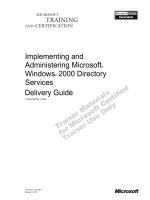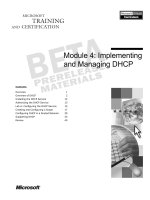specifying, implementing and verifying layered network protocols
Bạn đang xem bản rút gọn của tài liệu. Xem và tải ngay bản đầy đủ của tài liệu tại đây (392.78 KB, 127 trang )
© 2008
JOSEPH CWIKLA
ALL RIGHTS RESERVED
SPECIFYING, IMPLEMENTING AND VERIFYING LAYERED NETWORK
PROTOCOLS
A Thesis
Presented to
The Graduate Faculty of The University of Akron
In Partial Fulfillment
of the Requirements for the Degree
Master of Science
Joseph Cwikla
August, 2008
ii
SPECIFYING, IMPLEMENTING AND VERIFYING LAYERED NETWORK
PROTOCOLS
Joseph Cwikla
Thesis
Approved: Accepted:
______________________________ ______________________________
Advisor Dean of the College
Dr. Kathy J. Liszka Dr. Ronald F. Levant
______________________________ ______________________________
Faculty Reader Dean of the Graduate School
Dr. Timothy W. O’Neil Dr. George R. Newkome
______________________________ ______________________________
Faculty Reader Date
Dr. Yingcai Xiao
______________________________
Department Chair
Dr. Wolfgang Pelz
iii
ABSTRACT
As computing power increases, software is developed to make use of the
increased capacity. A transition is currently in progress as the growth of higher level
scripting languages enables a larger number of programmers to develop programs in
larger and more diverse domains. The world of software program development is
becoming readily accessible to a larger audience.
Concurrently, digital communication has revolutionized the way that people
interact. Protocols are established to enable new types of communication. Successful
protocols are built in layers; each layer makes use of the one below it and providing
services to the layer directly above it. As new uses are discovered for digital
communications, new protocols will need to be developed to support them.
Simulations are useful when communication protocols are developed. The
simulation can be specified, implemented and its runtime behavior verified against the
specification.
This thesis proposes and demonstrates that there exists a set of software
development tools that are readily accessible and end to end to address the problem of
specifying, implementing and verifying layered communication protocol simulations.
iv
TABLE OF CONTENTS
CHAPTER Page
I. INTRODUCTION 1
II. TOOLS 5
2.1 Specification Tools 6
2.2 Implementation Tools 21
2.3 Verification Tools 25
2.4 Example 29
III. MODEL 36
3.1 The Wireless Medium Layer 37
3.2 The Physical Medium Dependency Layer 38
3.3 The Wireless Channel Layer 38
3.4 The Physical Layer Convergence Procedure 39
IV. SPECIFICATION 41
4.1 Wireless Medium Specification 41
4.2 Physical Medium Dependency Specification 45
4.3 Wireless Channel Specification 47
4.4 Physical Layer Convergence Procedure Specification 48
V. IMPLEMENTATION 51
5.1 Wireless Medium Implementation 52
v
5.2 Physical Medium Dependency Implementation 61
5.3 Wireless Channel Implementation 69
5.4 Physical Layer Convergence Procedure Implementation 74
VI. DISCUSSION 84
BIBLIOGRAPHY 87
APPENDICES 89
APPENDIX A WIRELESS MEDIUM VERIFICATION CODE 90
APPENDIX B PHYSICAL MEDIUM DEPENDENCY
VERIFICATION CODE 99
APPENDIX C WIRELESS CHANNEL VERIFICATION CODE 106
APPENDIX D PHYSICAL LAYER CONVERGENCE PROCEDURE
VERIFICATION CODE 112
1
CHAPTER I
INTRODUCTION
Communication is ubiquitous and vital to our lives. It is also difficult to manage
correctly. Protocols are established and when followed permit some subset of possible
messages to be transmitted and hopefully received. When introduced to someone that we
don’t know we smile, possibly shake hands and say how glad we are to know that person.
A simple protocol but what set of messages can it convey? Not a large set certainly. As
the world leans more and more on electronic communication the set of messages that
need to be communicated across computer networks is growing. The protocols will need
to grow as well. But what electronic protocols need to be created? What will they
accomplish? Development of communication protocols is complicated and risky.
One way to mitigate the risk is to run simulations of the proposed candidate
protocols. This eliminates the need for an actual physical system. Rather, a model of the
system is employed. For the simulations to be meaningful the model must be precise,
even mathematical [1]. Once a precise model is specified, however, simulation provides
tangible benefits over working with real world systems [2].
• Time can be modeled. Working with real systems means that real time limits the
investigation. In a simulation, time itself can be modeled and expanded or compressed.
• Sources of variation can be controlled. These sources of variation must be
explicitly defined and it’s possible to limit these to the sources of interest.
2
• In real world systems measurement error is inevitable. In a simulation this is not a
concern since real world measurements are not being made. It is possible to stop and review a
simulation. All components in the simulation are frozen and a snapshot of global state can be
obtained and restored at any time. The value of simulation is indisputable when developing new
network protocols.
General purpose protocols need to be layered. The OSI model [3] defines seven layers,
while TCP/IP [4] defines five. Where would the internet be today if TCP were the only socket
interface available for network programmers? Certainly it’s the most used transport by programs
that communicate over the internet but the expense of connection setup and tear down sometimes
makes it a sub-optimal choice, especially when a reliable transport isn’t necessary. UDP serves a
different crowd.
So, not only is it necessary to simulate, but it’s necessary to simulate at different layers,
which means that it is necessary to reason about those layers independently and then be able to
combine them afterwards. More generally, it is advantageous to reason about a system at various
levels of abstraction in a way that permits conclusions to be drawn at each level. Even more
advantageous is being able to follow that up with a composition of those components, drawing
conclusions on the composed system based on the conclusions about the components.
Motivation for this work grew out of an experience with the use of a proprietary product
to develop a network simulation for wireless networks. The product was fine, well suited for the
task at hand. Issues came up however with license renewals and the inability to share the work
that was being done with anyone who did not have a license for the product. Also, it required a
“try it and see” approach. There was no discernable way to specify ahead of time within the tool
set what the system was supposed to do. Rather, it was necessary to implement it first and see
what it did.
3
The concepts of readily accessible, and end to end tools permeates this effort. The
approach being advocated is that the problem be understood and rigorously specified, a solution
attempted and then the results verified against expectations. So the challenge is to find the right
set of tools for the specification, implementation and verification phases; a set of tools that meet
the readily accessible and end to end goal.
The specification tools while being rigorous need to be understandable without special
training. They need to be simple yet powerful enough to specify complex systems. They must
provide facilities for composition so that behavior of network layers can be specified individually
and yet connected together to specify a complete protocol stack. The tools for specification
should generate output that can be consumed and utilized by the implementation phase of the
development. That is, there should be a link between the specification and implementation
phases.
The implementation tools must also be simple yet powerful. They must be capable of
implementing complex, composed system specifications while enforcing a separation of
concerns that expresses that specification more simply as an executable composition of its
components. The implementations must generate output that can feed the verification phase.
Thus, the tools must be amenable to capturing runtime behavior that can be determined to have
met the specification. The implementation tools must easy to learn and readily accessible.
The verification tools must be able to consume the output of the simulations and
demonstrate that the specifications have been satisfied, or not satisfied. Thus, there must be
linkage between the verification tools and both the specification and execution of the simulation.
verification.
The rest of this thesis attempts to show such a tool set. It identifies specific tools that are
appropriate for each phase. It explains how the development can flow within that set of tools
4
from specification through implementation and verification. Each phase is shown to be linked to
the next in the methodology described herein.
5
CHAPTER II
TOOLS
A programmer has an idea. He uses a text editor to express that idea precisely in
source code. He uses a compiler to transform that source code expression into an object
code expression of the idea. He uses a linker to transform the object code expression into
an executable expression of his idea. The executable expression is run on a computer and
shown to satisfy the idea. Text editor, compiler, linker, computer: a powerful tool set.
The tool set is linked, each tool takes the output of the previous one until the final result
is achieved. Text editors, compilers, linkers and computers are all, and have been for
some time, readily available to any programmer. This simple, readily available, end to
end linked tool set has provided development pipeline for many amazing products.
The value of an integrated methodology for specifying and verifying network
protocols has long been recognized [5] and research continues for today’s protocols [6].
The methodology advocated in this thesis defines an analogous tool set to that described
above for the composition of layered network simulations. Beginning with a
specification, a precise description of an idea is created. This initial specification is
expressed in terms of allowable external behavior; it is a behavioral specification. An
implementation specification can then be developed that is intended to satisfy the
behavioral specification. The implementation specification defines precisely a
component’s behavior, both internal and external, and can serve as input for translation
into an executable version of that component. Implementation tools can be identified that
6
facilitate that translation. Finally, executions of the components must be run and verified
against that behavioral specification to ensure correctness. It is the goal of this paper to
identify a tool set and a method that achieves these goals for the development of layered
network simulations.
2.1 Specification Tools
It’s been noted [7] [8] that an implementation of a system is correct if its actual
behavior is allowed by its specification. The specification tools must enable precise
descriptions of allowable behavior. They must also be usable without special skills or
training. Additionally, given a target of layered network simulations, the tools must
provide a way to model a shared medium at the lowest layer. The specification tools [7]
described below are:
Trace Properties
Trace properties are used to describe observable, that is external, component
behavior. Using simple set theoretic reasoning trace properties can precisely and
simply define behavior that can be externally verified. Trace properties are a
behavioral specification.
I/O Automata
I/O Automata precisely define the behavior, both internal and externally
observable, of a component. A component defined with an external interface that is
compatible with a trace property can be designed to produce only observable
behavior that is allowed by the trace property. Only a basic understanding of set
theory is needed to utilize I/O Automata. I/O Automata are an implementation
specification.
7
Shared Variable Types
Shared variable types are a formalism used to restrict the set of operations that may
be performed on a variable shared by multiple processes. They are needed here to
specify the behavior of the physical medium through which communication signals
travel. Two shared variable types are utilized, a read-write type and a read-modify
write type. As with all of the other specification tools, shared variable types are
understood using basic set theory. Shared variable types provide both behavioral
and implementation specifications.
I/O Automata
I/O Automata are simple state machines that can be used to model asynchronous
components of a system. The basic model has no notion of time and thereby
provides a very general model for the interaction between independently acting
entities. State transitions of an I/O Automata are associated with named actions
which supports a pre-condition, effect style of implementation specification
thereby providing a very code-like expression of each action’s functionality.
An I/O Automata A consists of five components:
• The signature of A, sig(A), is the set of named actions, acts, associated with A.
Each action is either an input, output, or internal action.
sig(A)= input(A) ∪ output(A) ∪ internal(A)
• The set of input actions and the set of output actions provide the external
interface of A.
external(A)= input(A) ∪ output(A)
8
• The set of internal actions and the set of output actions provide the locally
controlled actions of A.
local(A)= internal(A) ∪ output(A)
• The states of A, states(A), are described by a set of state variables. State
variables can be updated only by an action of A.
• The start states of A, start(A), is a non-empty subset of states(A).
• The state transition relation of A, trans(A), defines the relation between actions
and state transitions. trans(A) states(A) × acts(A) × states(A)
- An element (s, π, s´) of trans(A) is called a step, or transition of A.
- Each step is classified as an input, output or internal step depending on
whether π is an input, output or internal action.
- If (s, π, s´) is an element of trans(A) then the action π is said to be
enabled in s.
- All input actions π must be enabled in all states s. An I/O Automata
places no restrictions on its execution environment.
• The task partition of A, tasks(A), partitions the actions that A has control of into
separate, independent tasks.
Executions and Traces of Automata
An execution of I/O Automaton A, execution(A), is a sequence of alternating
states and actions of A beginning with an element from start(A) and ending with an
element from states(A).
execution(A)= s
0
,π
1
,s
1
,π
2
,π
r
,s
r
9
The trace of an execution of A, trace(A), is the subsequence of the execution consisting of
elements from external(A). trace(A) describes A’s externally observable behavior during
the execution. Trace Properties
A trace property, P, consists of two components:
• A trace signature, sig(P), which consists of external actions.
• A set of sequences, traces(P), of actions from sig(P) which defines the ordering
of actions allowed by the property.
A trace property specifies an interface and the allowable behavior at that interface.
An I/O Automata A can be said to satisfy a trace property P, if external(A) =
sig(P) and traces(A) ⊆ traces(P ). That is, if the signature of P is the same as external
signature of A and the set of all the traces that A can produce is contained in the set of
traces allowed by traces(P) then A satisfies P. In this case A can be said to be linked to P.
A Simple Example Define a trace property, TerraProperty, such that:
• sig(TerraProperty) = {sunlight(b), day, night} where b is a boolean
• traces(TerraProperty) is the set of sequences of actions from sig(TerraProperty)
such that:
1. day and night alternate, beginning with day.
2. After each day and before the next night there must be at least one
sunlight(false).
3. The first instance of day must be proceeded by a sunlight(true).
4. After each night there must be at least one sunlight(true) before the next day.
Now define an I/O Automata, Terra whose function is to recognize when the sun
is shining and transition between day and night accordingly.
10
• Terra Signature
- Input Actions = {sunlight(b)} where b is a boolean
- Output Actions = {day, night}
• Terra States = {sun, lastsun, newsun}, all boolean and initially false.
•Terra Task Partition = {day, night}
• Terra Transitions
- sunlight pre-conditions: None
- sunlight effects: lastsun := sun, sun := b, newsun := true
- day pre-conditions: newsun=true, lastsun=false, sun=true
- day effects: newsun := false
- night pre-conditions: newsun=true, lastsun=true, sun=false
- night effects: newsun := false
Some possible executions of Terra, with the state entries listed in parentheses and
corresponding to (sun, lastsun, newsun), are:
• (false, false, false), sunlight(false), (false, false, true), sunlight(false), (false,
false, true)
• (false, false, false), sunlight(true), (true, false, true), day, (true, false, false),
sunlight(true), (true, true, true)
• (false, false, false), sunlight(true), (true, false, true), day, (true, false, false),
sunlight(false), (false, true, true), night, (false, true, false)
11
Does the I/O Automata Terra satisfy the trace property TerraProperty? It does if
external(Terra) = sig(TerraProperty) and traces(T erra) ⊆ traces(T erraP roperty).
external(T erra)= {sunlight, day, night}
sig(T erraP roperty)= {sunlight, day, night}
TerraProperty.1
day must precede night because the state variable lastsun is initally false. A
precondition for night is that lastsun is true and the only way that lastsun can
become true is by a day action. Therefore night cannot be generated before day.
Thus, Terra cannot generate a sequence of external actions that violate this
specification.
TerraProperty.2
A precondition for day is that the state variable sun be true. A precondition for
night is that sun be false. The only action that updates sun is sunlight(b). So, after
a day action a sunlight(false) must occur to establish the precondition for night.
Thus, Terra cannot generate a sequence of external actions that violate this
specification.
TerraProperty.3
day cannot be generated until the state variable sun is true. sun is initially false
and since the only action that updates sun is sunlight(b) there must be a
sunlight(true) before the first day action can occur. Thus, Terra cannot generate a
sequence of external actions that violate this specification.
12
TerraProperty.4
This specification is a corollary to TerraProperty.2 Therefore, the traces of all
executions of Terra are permitted by TerraProperty. That is, traces(T erra) ⊆
traces(T erraP roperty) so Terra does in fact satisfy TerraProperty. The
implementation specification Terra is linked to the behavioral specification
TerraProperty. This simple example has demonstrated how a specification can be
written using trace properties and how an I/O Automata can be developed that
satisfies, or implements, the specification. The trace property and the I/O
Automata are linked. Note how the transitions of Terra were written in a pre-
condition and effect style as previously indicated. This is very similar to how an
implementation in a coding language could be accomplished. This style of
implementation specification facilitates a simple translation to an executable
implementation.
The next section explains how this approach applies not only to a single
specification and I/O Automata but to compositions of them as well.
Composition of Trace Properties and I/O Automata
An I/O Automata that satisfies a trace property provides an implementation of a
specification. For implementations of interest however, a single trace property and
automaton are usually insufficient. Systems of interest often must be composed of
independent components. Lynch [7] describes composition operations for trace properties
and I/O Automata. The composition of trace properties results in a composed trace
property while the composition of I/O Automata results in a composed I/O Automata.
13
The composition of both trace properties and I/O Automata require the notion of
signature compatibility. For a collection of signatures, {Si}iI , to be compatible then for
all i, j ∈ I,i ≠ j the following must be true:
1. internal(S
i
) ∩ actions(S
j
)= ∅ That is, an action that is an internal action in any
of the components cannot be an action of any kind in another component.
2. output(S
i
) ∩ output(S
j
)= ∅ That is, an output action in any component cannot
also be an output action in any other component.
These two restrictions ensure that locally controlled actions are limited to a single
component in the compositions. A collection of trace properties or a collection of I/O
Automata are compatible and may be composed if their signatures are compatible.
The composition S of a compatible collection of signatures is defined as:
• output(S) = ∪
i
∈
I
output(S
i
)
• internal(S) = ∪
i
∈
I
internal(S
i
)
• input(S) = ∪
i
∈
I
input(Si) − ∪
i
∈
I
output(Si)
Note that an action that is an input action in one signature and output action in
another signature becomes an output action in the composition thereby becoming a
locally controlled action of the composition and still available for communication with
other components in further composition.
Trace properties may be composed if their signatures are compatible.
Composition of trace properties results in a trace property. That is, it results in a signature
and an allowable set of sequences of actions from that signature. The composed trace
property P is defined as:
14
• sig(P)= composition(
i
∈
I
sig(P
i
)). The composition of signatures previously
defined.
• A set of sequences, β, of actions from sig(P) which defines the ordering of
actions allowed by the property such that the projection of β onto actions(P
i
),(β |
actions(P
i
)), results in a sequence allowed by P
i
.
∀
i
∈
I, (β | actions(P
i
))
∈
traces(P
i
)
Thus, it is possible to pull from the trace of a composed system the traces of the
individual components. This allows examination of the behavior of the individual
components independently from the trace of a composed system execution. This
characteristic of composed trace properties will be explored further later on.
I/O Automata may be composed if their signatures are compatible. Composition
of I/O Automata results in an I/O Automata. A composed I/O Automata A is defined as:
• sig(A)= composition(
i
∈
I
sig(A
i
)). The composition of signatures previously
defined.
• states(A)= composition(
i
∈
I
states(A
i
)). The states of the composition is the
cartesian product of the component states.
• start(A)= composition(
i
∈
I
start(A
i
)). The start states of the composition is the
cartesian product of the component start states.
• trans(A) consists of the set of tuples (s
i
, π, s
i
) such that,
∀
i ∈ I, if π ∈
actions(A
i
) then the tuple ∈ trans(A
i
). If (s
i
, π, s
i
)
∈
trans(A
i
) then s
i
= s
i
. That is, steps,
and their corresponding updates to the automaton’s state happen component wise.
15
Recall that when I/O Automata are composed, the actions that are an input action
of one component and an output action of another component become output actions of
the composition. The composition turns the two independently defined actions and
combines them into a single action. This requires that when the composition occurs that
output component action and the input component action occur atomically. If further
communication via such an action isn’t desired then it is possible to hide this action,
making it an internal action of the composition.
Since the composition of trace properties results in a trace property and the
composition of I/O Automata results in an I/O Automata, it is possible to apply
compositional reasoning to a system built from components. Importantly, reasoning about
individual trace properties and I/O Automata can lead to conclusions about the
composition. This means that understanding larger, more complex, composed systems by
can be obtained by examining their simpler components individually.
Example Composition
Define a trace property, SolProperty such that:
• sig(SolProperty) = {sunlight(b)} where b is a boolean
• traces(SolProperty) is the set of all possible sequences of actions from
sig(SolProperty)
16
If sunlight(b) is not an output action in both SolProperty and TerraProperty then
their signatures are compatible and the two trace properties may be composed. Now
define an I/O Automata, Sol whose job it is to output sunlight(true) half the time and
sunlight(false) half the time.
• Sol Signature
- Output Actions = {sunlight(b)} where b is a boolean
- Internal Actions = {incrementDegrees}
• Sol States = { integer degrees =0, boolean shining = true}
• Sol Task Partition = {{sunlight(b)}, {incrementDegrees}}
• Sol Transitions
- sunlight(b) pre-conditions: b = shining
- sunlight(b) effects: None
- incrementDegrees pre-conditions: None
- incrementDegrees effects: degrees := degrees+1, if degrees modulo 360 < 180
then shining := true else shining := false
Does the I/O Automata Sol satisfy the trace property SolProperty? It does if
external(Sol) = sig(SolProperty) and traces(Sol) ⊆ traces(SolProperty).
external(Sol)= {sunlight} sig(SolProperty)= {sunlight}
17
SolProperty.1 There is no restriction placed on the sequences of sunlight(b) by SolProp-
erty so clearly:
traces(Sol) ⊆ traces(SolProperty)
Some possible executions of Sol, with the state entries listed in parentheses and
corresponding to (degrees, shining), are:
• (0, true), sunlight(true), (0, true),
• (0, true), incrementDegrees, (1, true), sunlight(true), (1, true), sunlight(true), (1,
true),
• (0, true), incrementDegrees, (1, true), , incrementDegrees, (181, false),
sunlight(false), (181, false),
Therefore Sol satisfies SolProperty.
In the two I/O Automata Terra and Sol, sunlight is an external action. But in
Terra it is an input action whereas in Sol it is an output action. Thus the corresponding
trace properties, TerraProperty and SolProperty may be composed. Also, the signatures
of Terra and Sol are compatible so the two I/O Automata may be composed as well.
The composition of the trace properties SolProperty and TerraProperty results in
a trace property SystemProperty such that:
•sig(SystemProperty) = {sunlight(b), day, night} where b is a boolean
• traces(SystemProperty) is the set of sequences of actions from
sig(SystemProperty) such that:
1. day and night alternate, beginning with day
2. after each day and before the next night there must be at least one
sunlight(false)
3. the first instance of day must be proceeded by a sunlight(true)
18
4. after each night there must be at least one sunlight(true) before the next day
5. sunlight(b) has no further constraints.
The composition of the I/O Automata Terra and Sol results in the I/O Automata
System:
19
• System Signature
– Output Actions
∗ sunlight(b), where b is a Boolean
∗ day
∗ night
– Internal Actions
∗ incrementDegrees
• System States
– degrees, an integer initially 0
– shining, a, boolean initially true
– sun, a, boolean initially false
– newsun, a, boolean initially false
• System Task Partition
– {sunlight(b)}
– {incrementDegrees}
– {day, night}
• System Transitions
– sunlight(b)
- precondition: b=shining
- effect:
lastsun := sun
sun := b
newsun := true
– day
- precondition
newsun = true
lastsun = false
sun = true
- effect:
newsun = false
– night
- precondition
newsun = true
lastsun = true
sun = false
- effect:
newsun = false
– incrementDegrees
- effect:
degrees = degrees+1
if degrees modulo 360 < 180
then shining := true else
shining := false
Does the System I/O Automata satisfy the SystemProperty trace property?
external(SystemProperty)= {sunlight(b), day, night}
external(System)= {sunlight(b), day, night}
SystemProperty.1 day must precede night because the state variable lastsun is









